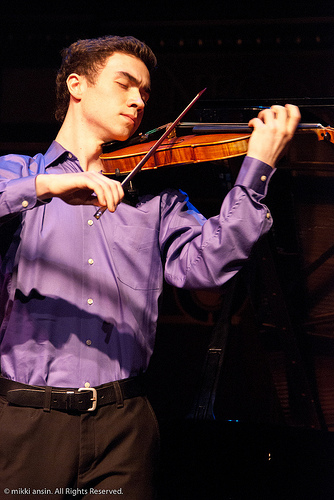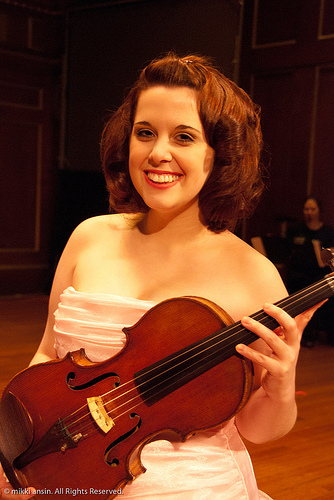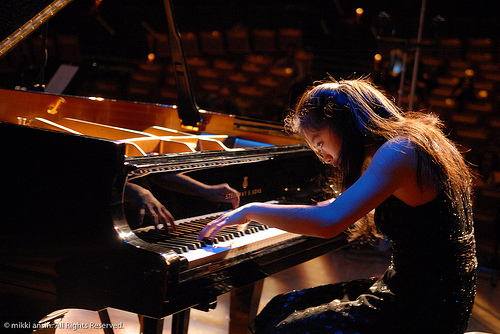Show 245: Listening Guide
From the Top’s Show 245 was taped at New England Conservatory’s Jordan Hall in Boston, Massachusetts on Saturday, February 4, 2012. We asked our performers to tell us about the music they performed on the show:
Gordon Neidinger, Mandolin, 17
Doina and Variations of the E-Flat Sirba
By: Charles Rappaport
I think the most important thing about playing this piece is conveying the light, energetic spirit of the dances it’s based upon – it’s very easy to fall into “just playing the  notes” without any feeling or verve. The hardest part of this piece is getting all the notes right while also giving it life, particularly in the beginning and end, both of which have particularly difficult sections. Playing accurately requires great concentration; playing with feeling requires one to “let go”. Balancing technicality and feeling – being able to play with both at the same time – is a challenge common to all music, but it seems particularly important in this piece.
notes” without any feeling or verve. The hardest part of this piece is getting all the notes right while also giving it life, particularly in the beginning and end, both of which have particularly difficult sections. Playing accurately requires great concentration; playing with feeling requires one to “let go”. Balancing technicality and feeling – being able to play with both at the same time – is a challenge common to all music, but it seems particularly important in this piece.
One interesting thing about the Doina and E-flat Sirba is that Charley Rappaport, the composer, is also my teacher. He wrote this piece based on a traditional Romanian dance tune, adding a number of variations and the Doina, which he wrote from scratch. He also drew on the repertoire of his own teacher, Martin Kalisky, adding as an interlude a melody of Kalisky’s, and my suggestion of raising the octave of the ending. My favorite part is the section in the middle that utilizes a drone effect because this technique is unique to the mandolin and related instruments. It’s very powerful, and I think it really jumps out at the listener. This technique was pioneered on the mandolin by Martin Kalisky. It’s an honor for me to be the first person to perform this piece.
I’ve been studying with Charley for five years. For the last year and a half, we’ve also been travelling the country, performing together everywhere from Los Angeles to New York City. Collaborating with him on the interpretation and organization of his piece has been very interesting experience. Studying with Charley – performing with him and jamming with him, travelling with him and just talking with him – has had a profound influence on me both musically and personally.
Post Show Reflection: There are so many memories for only three days! I really enjoyed meeting the other performers and hearing their stories and seeing and hearing them play. It’s inspiring to meet other kids who love music and dedicate so much time to it! The From The Top staff is amazing – they’re all extremely friendly, easy to work with and very professional. They made it so easy to play – I felt like I could just do my best without having to worry about anything else. Playing with Christopher O’Reilly was amazing! It was so much fun.
I believe music has the ability to change people’s lives. I think it perfectly demonstrates how hard work and passion can get you very far. Performances have always inspired me to work harder.
Carson Marshall, Violin, 18
II. Andante Scherzando from the Violin Sonata No.3
By: Frederick Delius
When I play this piece of music, I am constantly battling with the idea of making the music interesting and beautiful for the audience, yet maintaining the simplicity that the composer clearly wrote into the music. I always try to think about where each  phrase is going, what its function is, and what my sound is communicating to the audience.
phrase is going, what its function is, and what my sound is communicating to the audience.
My favorite part of the piece is the part where the piano has a solo that is then echoed by the violin. It is the same music, but how it is played is solely up to the discretion of the player. I also like the end, being somewhat strong, it’s fun to play. My least favorite part is this one measure that is quite hard to play in tune, it’s kind of hit or miss, and can be frustrating sometimes. But other than that I love the piece.
The most important thing to get across in this piece is a sense of ease and effortlessness of playing, which flows from one phrase to the next without too much meandering. This piece while not especially virtuosic is difficult because the intonation is up for interpretation as much as the phrasing. So, centering and deciding on an effective standard of intonation is difficult. This piece holds a special significance for me because I had wanted to play it for a long time, and was never able to find the music for it. Then over the summer at Interlochen, I found it in the library. So as I play it, I’m reminded of how we should not to take the music we have today for granted, and feel lucky to be able to share this piece with others.
Post Show Reflection: My favorite memories were meeting all the staff and seeing how supportive they all are. During the actual performance, the light was bright enough so when I was playing I wasenveloped in light. All I could feel was my instrument and what Chris was doing.
Music has the power to change lives and reach people in ways that words cannot.
Alexia DelGiudice Bigari, Viola, 17
Rhapsodie from Suite Hebraique
By: Ernest Bloch
This piece has a really special place in my heart. When I play this piece, the Holocaust comes to my mind. I created a story for thispiece: the story is about a young boy who is  sent to a concentration camp with his mother and what he is going through. One time when I was playing this piece, I started to cry because of how emotional it was.
sent to a concentration camp with his mother and what he is going through. One time when I was playing this piece, I started to cry because of how emotional it was.
This piece is very unique because it is harmonic throughout. Since it is in harmonic minor, it gives off a very sad and emotional feeling. The feeling of the piece is very moody and it sounds in a way like a person crying out for help. The hardest part to nail would have to be the part when I to play the scales very high upon the fingerboard. I got so annoyed while practicing that.
Post Show Reflection: My favorite moment were hanging out in the green room, taking pictures and laughing, and playing the Bloch with Christopher O’Riley. At first, I was very nervous because I have never played a solo performance in a place like Jordan Hall. It has the most amazing acoustics, and when I started playing, all of my nerves flew away. It was amazing!
Music is a universal language so potentially; it could save the world and bring everyone together.
Anthony Trionfo, Flute, 16
Andante Pastoral et Scherzettino
By: Paul Taffanel
The Andante Pastoral section of this piece is great to play because it is very thoughtful and seems to ask a very deep question. The melodies are very imploring, but the answer never seems to come. You have slight moments of irritation, acceptance, and  playfulness all for a simple answer. The Andante ends with an idea that the question will never be answered, when the Scherzettino comes. It is extremely playful and joking and shows you that the answer is right in front of your face!
playfulness all for a simple answer. The Andante ends with an idea that the question will never be answered, when the Scherzettino comes. It is extremely playful and joking and shows you that the answer is right in front of your face!
This piece offers a lot of room for rhythmic freedom, and it is difficult to balance rubato with metered time without compromising flow.This piece can seem extremely stagnant so it is very important to constantly think about motion and playing in the magical space between notes. Although the Scherzenttino is very fun, you still need to maintain your center and not get too crazy
Post Show Reflection: One of my favorite memories from the past few days was waiting in the green room before the show with everyone. The energy wasawesome and it was so fun to feed off of everyone’s energy. Performing on stage was magical. The lights were dimmed and I felt free to let myself sing with my flute into the hall.
Music has the power to bring life and energy into silence. It has the power to convey all emotions that cannot be shown through words.
Angie Zhang, Piano, 15
Basso Ostinato
By: Rodion Shchedrin
When I play this piece I imagine an act of a play with synchronized robbers who try to rob the Great Pyramid of Giza. I imagine the sudden Fortes and dynamic changes in  the Basso Ostinato to be various traps in the pyramid. The synchronized steps of the robbers are the repeating and constant ostinato in the bass.
the Basso Ostinato to be various traps in the pyramid. The synchronized steps of the robbers are the repeating and constant ostinato in the bass.
From my point of view, this piece is an exciting and interesting piece to play and share. It is a showy and festive piece. The syncopations are really important in the piece because it adds moments of surprise and suspense to the piece. The dynamic changes are also very effective. For me, the hardest thing to nail in this piece is the left hand. The reason is because the notes have to be evenly spaced and I have to play them at the precise moment to make the most out of the basso ostinato.
Post Show Reflection: One of the many memories I have from these 3 days would be the dress rehearsal/recording because it was really funny at moments and playing in the hall was a great experience. The performance was definitely a dream come true for me. I loved the acoustics and the piano was phenomenal! Talking to Chris was exciting and the audience was so friendly and had a great sense of humor.
Music has the power to change people’s lives forever. Music has the ability to help people through troubled times, and music can also bringhappiness that nothing else can. Music changes the way we feel about life.



